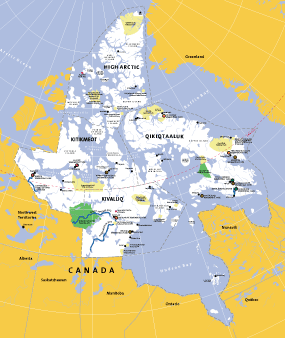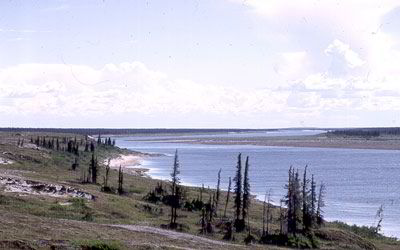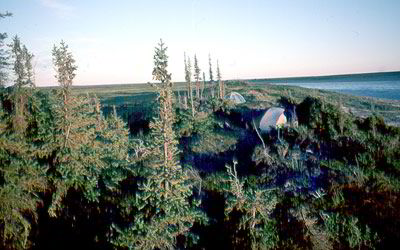Nunavut
Nunavut is one of three "Territories" in Canada. Nunavut (the Inuktitut word for “our land”) was
created April 1, 1999 as a result of the Nunavut Land Claims Agreement. For millennia a major
Inuit homeland, Nunavut today is a growing society that blends the strength of its
deep Inuit roots and traditions with a new spirit of diversity.
It is a territory that spans the two million square
kilometres of Canada extending north and west of Hudson’s Bay, above the tree line to the
North Pole. With landscapes that range from the flat muskeg of the Kivalliq to the
towering mountain peaks and fiords of North Baffin, it is a Territory of extraordinary variety
and breathtaking beauty. http://www.gov.nu.ca/Nunavut/English/about/ourland.pdf
 Nunavut
Nunavut
| On March 14, 2010 the Eastern Native Tree Society
and Western Native Tree Society switched from discussion lists
on Google Groups to a new discussion list in a Bulletin Board
format at:
http://www.ents-bbs.org/index.php
Posts made since the inception of the BBS on March 14, 2010 will
be sorted and archived on the BBS. Click on the link to go to
the equivalent section on the new BBS. This website will
continue to serve as a front end for the ENTS and WNTS groups.
It will continue to serve as a repository of older posts, and
will serve as the host site for special projects and features
that are not well suited for a BBS format. Please visit the BBS
for the latest information and trip reports. |

Southern and western areas of Nunavut are forested by the northern
edge of the great boreal forests. At the boundary between the
boreal forest and the tundra is a transition zone of mixed spruce forest
patches and tundra. One prominent feature of western Nunavut is
the Thelon River. The official government website reads as
follows: http://www.nunavutparks.com/on_the_land/thelon_river.cfm
The Thelon is the largest river in Nunavut flowing into Hudson Bay. It winds through a broad valley, often lined with thick stands of spruce, surrounded by the sweeping barren lands - the treeless tundra of Canada's north. This boreal-Arctic oasis supports a rich and unusually diverse northern concentration of wildlife. The 500,000 strong,
Beverly-Qaminariak caribou herd, crosses the river in large groupings at a number of spots during the herd's annual migration. Barren-ground grizzly, muskox, fox, lynx, wolf, moose, wolverine, peregrine falcon and more than 10,000 moulting Canada geese are common here, many in the Thelon Game Sanctuary which surrounds the river's middle reaches to Beverly Lake.
The Thelon, together with its sister river, the Kazan, has long been home to the Caribou Inuit, the only inland community of Inuit in Canada. The shores of the Thelon, particularly from Beverly Lake downstream, are a treasure-house of pre-historic artifacts and Inuit campsites, some dating back thousands of years.
The Kazan and Thelon sweep majestically out of spruce-lined valleys, winding across the barrens through vast shimmering lakes set like mirrors in the treeless tundra, finally emptying into Baker Lake. For the Inuit of the village of Baker Lake, these rivers remain a vital source of caribou, fish and spiritual renewal. Remains of Inuit campsites are found all along these rivers, testimony of a time not so long ago when these were the homelands of the nomadic Caribou Inuit. Paddle through a land of staring muskox, white wolves, soaring gyrfalcons and wandering grizzly bears, a land where vast herds of caribou - hundreds of thousands strong - still migrate to ancient rhythms.

From as far apart as 200 km east of Great Slave Lake and the northern Saskatchewan border, waters of the Thelon collect to flow for 900 km across the NWT's Mackenzie district, then through Nunavut into Baker Lake and Chesterfield Inlet. This 142,400 km2 watershed is the largest unaltered drainage basin emptying into Hudson Bay.
The section designated a Canadian Heritage River includes the river's entire middle and lower reaches, consisting of the 545 km from Warden's Grove, 50 km from the river's junction with the Hanbury, to Baker Lake. The 1-2 km wide, meandering, river channel contains considerable fast water but requires no portages from the Hanbury junction to the lower reaches where the Thelon widens into three vast lakes: Beverly, Aberdeen and Schultz. From Schultz Lake, the river narrows and a 100 km stretch of fast water leads to the river's mouth at Baker Lake.
Located at the geographic center of Canada and inaccessible by road, Baker Lake is 900 km by air east of Yellowknife, and 1500 km by air north of Winnipeg. Nevertheless hotel accommodation, food, supplies, outfitting and other services are among the best available in the far north, and Baker Lake offers visitors an unforgettable taste of the modern Caribou Inuit cultural way of life.
The pristine wilderness of the Thelon provides abundant and diverse wildlife habitat and many areas of exceptional natural beauty. Its forest-tundra supports a unique assemblage of boreal and arctic species and some of Canada's most important northern ecosystems.
Among its more significant features are:
500,000 migrating caribou, following the river to calve north of Beverly Lake, sometimes swimming across in a kilometre-wide band;
the largest flock in Nunavut of the large species of Canada geese, between Beverly and Aberdeen lakes;

one of few inland colonies of lesser snow geese; breeding grounds for the endangered peregrine, gyrfalcon and rough-legged hawk and habitat for the rare wolverine, and for arctic fox and wolf; 75-100 moose and more than 2,000 muskox between Warden's Grove and Lookout Point. The muskox have thrived under protection of the Thelon Wildlife Sanctuary. At the turn of the century, only a few hundred survived, decimated by the late 19th century European demand for muskox robes;
important denning grounds for barren-ground grizzly preying on geese and eggs in spring and summer;
an uncommon mix of boreal and arctic fish species in Beverly Lake; and, impressive scenic features: extensive flats of pure white sand at the Thelon-Hanbury junction and Lookout Point; 15m high sand embankments fringed by boulder beaches at Thelon Bluffs, where rapids course through sandstone cliffs; seven terraces 20-l00 m high - old lake and marine beaches, at West Aberdeen; and, the spectacular Aleksektok Rapids, 70 km from Baker Lake.

Cabins still stand at Warden's Grove. Here the finest stand of spruce trees on the river shelter three cabins one built in 1928 by the park's first warden, W.B. Hoare and another in the 1960's by the Canadian Wildlife Service for wildlife research. Ernie Kuyt, famous for his work with sandhill cranes, was one of the first biologists stationed here.
|



